
In Industrial and factory settings, it is crucial to measure the total power consumed and the current flow accurately. This is where transformer-rated energy meters come into play, and Current Transformers (CTs) are a vital component of these meters. Unlike energy meters used in homes, CTs are required for Transformer-rated energy meters to measure the electrical energy consumed, especially when the current is above 50A.
Current Transformers are typically used to measure line currents that are beyond the range of conventional analog and digital ammeters.
There are different types of CTs available with various parameters and features. In this blog, we will discuss the factors to consider when choosing a right current transformer for metering.
1. Application: Determine the purpose of CT and type of load it will be measuring. Common applications of Current Transformers include: Revenue metering, power system protection, current control and monitoring, ground fault protection and distance / differential protection.
Indoor Metering Current Transformer

up to 1.1kV
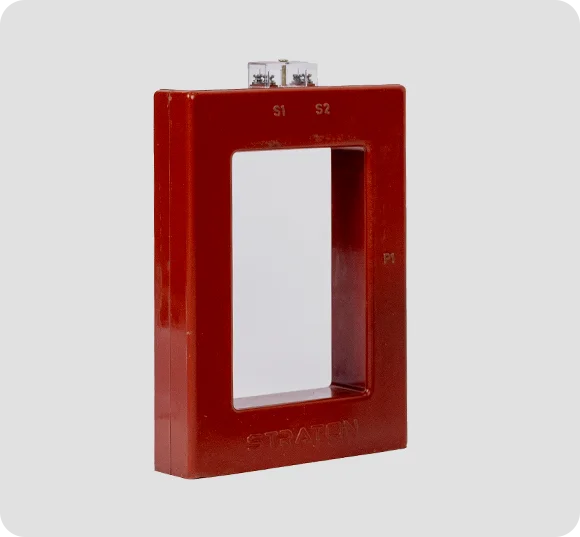
up to 1.1kV
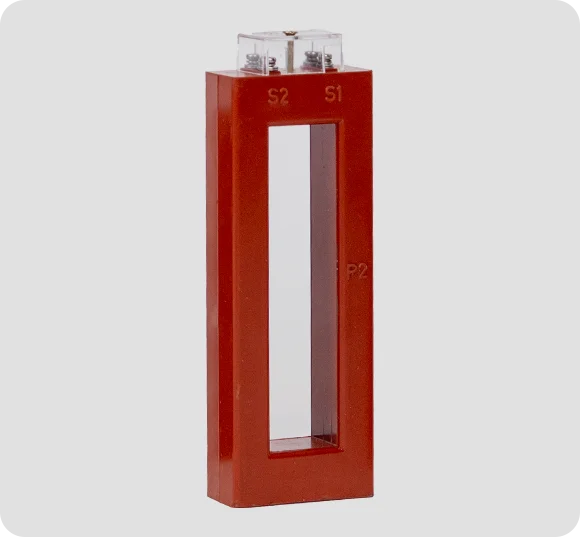
up to 1.1kV

up to 1.1kV
2. Accuracy Class: 2.The accuracy class defines the error tolerance of the CT, which is expressed as a percentage of the rated primary current. The latest standards, namely IEC-61869-1&2 / IS-16227-1&2-2016, specify the acceptable accuracy classes for CTs as 0.1, 0.2s, 0.2, 0.5s, 0.5, 1, 3 and 5. The 0.2 accuracy class means the CT has a specified error tolerance of 0.2% of the rated primary current.
In other words, when the actual primary current flows through the CT, the output current should be within 0.2% (+/- 0.2 band) at full and quarter burdens. When conducting accuracy tests for 0.2s and 0.5s class, the test is typically performed at primary currents ranging from 1% to 120% of CTs rated primary current. During this test, the CT’s output current must be within a specified error band of +/- 0.2 and +/- 0.5 respectively. For remaining accuracy classes, tests are performed at primary currents ranging from 5% to 120% of CTs’ rated primary current.
A CT ratio measures the ratio between primary and secondary currents. Understanding the appropriate CT ratio is essential for accurate and reliable current measurements in metering applications.
As per IEC-61869-1&2 / IS-16227-1&2:
Limits of ratio error and phase displacement for measuring current transformers (classes 0.2s and 0.5s)

| Accuracy class | Ratio error ± % |
Phace displacement | ||||||||||||||
| ± Minutes | ± Centiradians | |||||||||||||||
| At current (0% of rated) | At current (0% of rated) | At current (0% of rated) | ||||||||||||||
| 1 | 5 | 20 | 100 | 120 | 1 | 5 | 20 | 100 | 120 | 1 | 5 | 20 | 100 | 120 | ||
| 0,2 S | 0,75 | 0,35 | 0,2 | 0,2 | 0,2 | 30 | 15 | 10 | 10 | 10 | 0,9 | 0,45 | 0,3 | 0,3 | 0,3 | |
| 0,5 S | 1,5 | 0,75 | 0,5 | 0,5 | 0,5 | 90 | 45 | 30 | 30 | 30 | 2,7 | 1,35 | 0,9 | 0,9 | 0,9 | |
Limits of ratio error and phase displacement for measuring current transformers (classes 0.1 to 1)

| Accuracy class | Ratio error ± % |
Phace displacement | ||||||||||
| ± Minutes | ± Centiradians | |||||||||||
| At current (0% of rated) | At current (0% of rated) | At current (0% of rated) | ||||||||||
| 5 | 20 | 100 | 120 | 5 | 20 | 100 | 120 | 5 | 20 | 100 | 120 | |
| 0,1 | 0,4 | 0,2 | 0,1 | 0,1 | 15 | 8 | 5 | 5 | 0,45 | 0,24 | 0,15 | 0,15 |
| 0,2 | 0,75 | 0,35 | 0,2 | 0,2 | 30 | 15 | 10 | 10 | 0,9 | 0,45 | 0,3 | 0,3 |
| 0,5 | 1,5 | 0,75 | 0,5 | 0,5 | 90 | 45 | 30 | 30 | 2,7 | 1,35 | 0,9 | 0,9 |
| 1 | 3,0 | 1,5 | 1,0 | 1,0 | 180 | 90 | 60 | 60 | 5,4 | 2,7 | 1,8 | 1,8 |
Limits of ratio error for measuring current transformers (classes 3 and 5)
| Class | Ratio error ± % |
|
| At current (0% of rated) | ||
| 50 | 120 | |
| 3 | 3 | 3 |
| 5 | 5 | 5 |
As per IEEE C57.13-2016:

| Burdens | Burden Designation | Resistence | Induetence | Impedence | Total Power | Total Power | Power Factor |
|---|---|---|---|---|---|---|---|
| Electronic burdebs | E0.04 | 0.04 | 0 | 0.04 | 1.0 | 0.04 | 20 |
| E0.2 | 0.2 | 0 | 0.2 | 5.0 | 0.2 | ||
| Metering burdens | B-0.1 | 0.09 | 0.116 | 0.1 | 2.5 | 0.1 | 0,9 |
| B-0.2 | 0.18 | 0.232 | 0.2 | 5.0 | 0.2 | ||
| B-0.5 | 0.45 | 0.580 | 0.5 | 12.5 | 0.5 | ||
| B-0.9 | 0.81 | 1.040 | 0.9 | 22.5 | 0.9 | ||
| B-1.8 | 1.62 | 2.080 | 1.8 | 45.0 | 1.8 |
Standard metering burdens for current transformers with 5A secondary windings
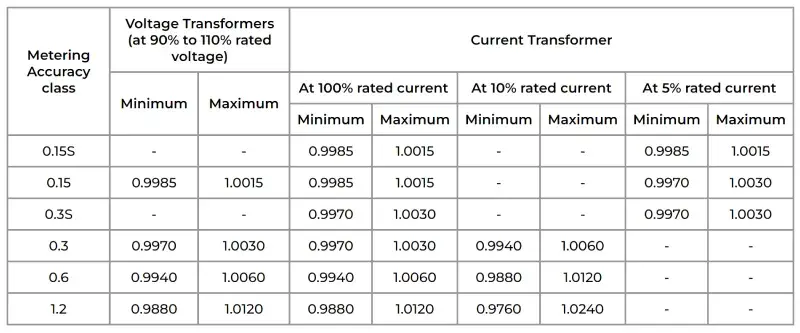
| Metering Accuracy class | Voltage Transformers (at 90% to 110% rated voltage) |
Current Transformer | ||||||
| Minimum | Maximum | At 100% rated current | At 10% rated current | At 5% rated current | ||||
| Minimum | Maximum | Minimum | Maximum | Minimum | Maximum | |||
| 0.15S | – | – | 0.9985 | 1.0015 | – | – | 0.9985 | 1.0015 |
| 0.15 | 0.9985 | 1.0015 | 0.9985 | 1.0015 | – | – | 0.9970 | 1.0030 |
| 0.3S | – | – | 0.9970 | 1.0030 | – | – | 0.9970 | 1.0030 |
| 0.3 | 0.9970 | 1.0030 | 0.9970 | 1.0030 | 0.9940 | 1.0060 | – | – |
| 0.6 | 0.9940 | 1.0060 | 0.9940 | 1.0060 | 0.9880 | 1.0120 | – | – |
| 1.2 | 0.9880 | 1.0120 | 0.9880 | 1.0120 | 0.9760 | 1.0240 | – | – |
Standard accuracy class for metering service and corresponding limits of transformer correction factor and ratio correction factor [0.6 to 1.0 power factor (lagging) of metered load]
A higher accuracy class means the CT will have a lower error tolerance and provide more precise measurements. However, a higher accuracy class typically comes at a higher cost. Therefore, it’s essential to choose an accuracy class that meets your application requirements while also being cost effective.
Outdoor Metering Current Transformer

2.2kV to 36kV
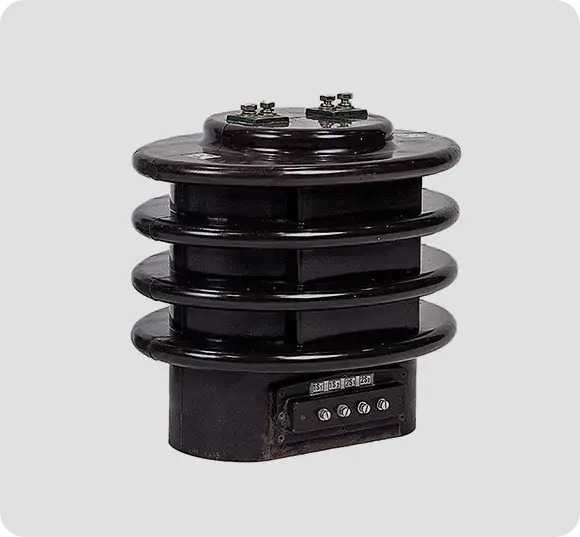
2.2kV to 36kV
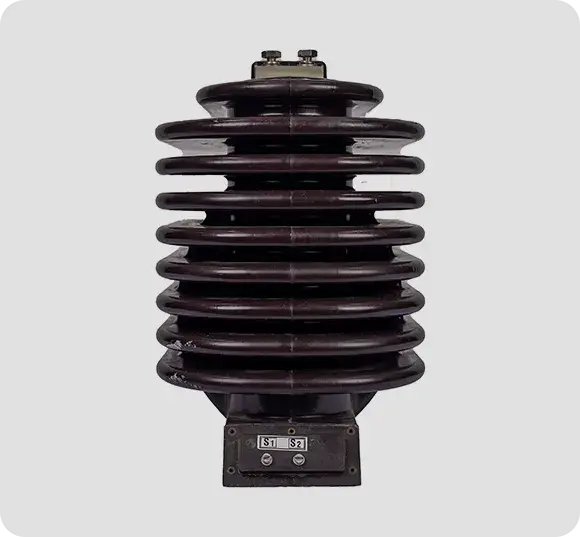
2.2kV to 36kV
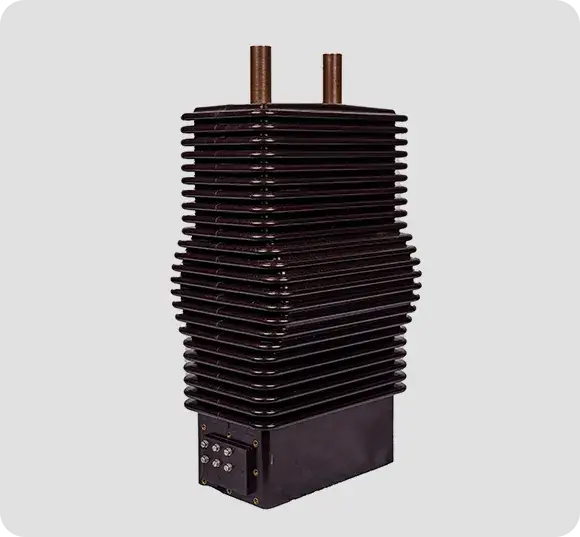
2.2kV to 36kV
3. Burden: The burden of a CT is the total load that the CT secondary circuit must drive, which includes resistance of the connected measuring device. Choosing a CT with correct burden is crucial to ensure accurate measurements. If the burden is too low, the CT’s accuracy will be affected, while a burden that is too high may cause the CT to overheat or provide inaccurate measurements. Calculate your connected load based on CT secondary (output) current, resistance of connecting leads and resistance of connected load.
(VA=2*I2R(leads)+I2R(burder))
4. Instrument Security Factor (ISF): Instrument Security Factor (ISF) refers to a safety factor used in the design and selection of Current Transformers (CTs) to ensure reliable and safe operation of connected load and system. The ISF considers various factors such as the level of system fault current, the accuracy and performance, and the safety margin required to protect the instrument from damage or failure under fault conditions. The ISF is expressed as a numerical value that represents the ratio of maximum system fault current to the rated current of the Instrument. Standard I.S.F values of CT are FS 5 and FS 10.

5. Short-Time Current Rating: The customer must carefully specify the short-withstand withstand rating of a current transformer, either based on short time current (STC) rating of their breaker or the short circuit level of the distribution transformer. The STC rating is expressed as kA/s. For example, if a CT has an STC rating of 25kA / 1s, It means that the CT must be able to withstand a high current pulse of 25,000A for a duration of 1s without any degradation in its accuracy or damage to its thermal and mechanical properties.
This underscores the importance of selecting the appropriate STC rating for CTs used in power systems and other applications where short-short circuit faults may occur.
6. Physical Aspects: Considerations such as the installation location (indoor / outdoor), level of pollution, and Basic Insulation Level (BIL) are important factors to take into account when selecting a Current Transformer.
Regulation Requirements
Different countries have different regulations when it comes to electrical equipment. This is mainly for safety reasons but is also to ensure that that operation is at a high enough standard and accuracy. Similarly, there are regulatory requirements for current transformers.
In India, the Bureau of Indian Standards has developed a standard called IS 16227, 2016, which defines the requirements for CTs. In the United States, the ANSI (American National Standards Institute) standard C57.13 outlines the general requirements for current transformers used in revenue metering. In Europe, the IEC (International Electrotechnical Commission) standard 60044 defines the requirements for current transformers used in metering and protection applications. It’s important to be aware of these regulations and ensure that the current transformers you choose meet the necessary standards.
Conclusion Current transformers are a critical component of transformer-rated energy meters, used to measure the total power consumed and current flow. When selecting current transformer for metering, it’s important to consider the CT input and output, CT ratio, accuracy rating, transformer size and type, and regulation requirements. By taking these factors into account, you can choose a current transformer that meets your specific needs and ensures accurate and reliable energy measurement.
Starting from 2012, we have amassed substantial expertise in manufacturing Metering Current Transformers tailored to diverse specifications for customers. The Current Transformers we produce are diligently fabricated to comply with a range of standards (IEC, ANSI, etc.), ensuring they meet the required specifications for our valued clients.
Recently, we have been approved by RDSO, EIL, and MES, demonstrating our commitment to delivering quality and reliability.